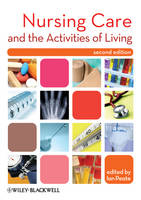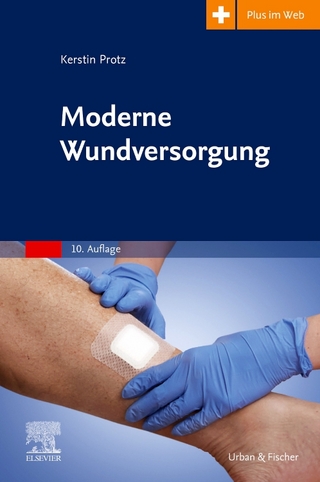
Nursing Care and the Activities of Living
Wiley-Blackwell (Verlag)
978-1-4051-9458-7 (ISBN)
Ian Peate is Head of the School of Nursing and Midwifery, Thames Valley University, UK
Contributors xi
Acknowledgements xv
Introduction – Ian Peate xvii
1 The Nature of Nursing 1
Lynn Quinlivan
Introduction 1
The Nursing and Midwifery Council 2
Registration and professional accountability 2
Standards of conduct and performance 3
Maintenance of a register of nurses and midwives 3
Duty of care 4
Fitness to practise 5
Nurses and accountability 5
Nursing hierarchy 6
Government directives 9
The structure of the NHS in England 13
The structure of the NHS in Scotland 15
The structure of the NHS in Wales 15
The structure of the NHS in Northern Ireland 15
Conclusions 16
References 17
2 Safeguarding Vulnerable Adults 19
Victoria Darby
Introduction 20
Defining a vulnerable adult and abuse 20
Ethics and safeguarding the vulnerable adult 23
Policies and legislation for safeguarding the vulnerable adult 28
Safeguarding vulnerable adults from unprofessional nurses 32
Fitness to practise panels 32
Interprofessional collaboration 33
Reporting suspicions of abuse as a nurse 33
Assessing the seriousness of abuse 34
Reporting suspicions of abuse as a student nurse 34
Conclusions 35
References 36
3 Assessing Needs and the Nursing Process 38
Lynda Sibson
Introduction 39
Models of nursing 39
Activities of living 40
Organisation of nursing care 40
Nursing practice 41
Nursing history 41
Elements in nursing 42
Theories, concepts and models 43
Nursing process 46
Conclusions 57
References 58
4 Promoting Safety 60
Janet G. Migliozzi
Introduction 60
Risk assessment 61
Common risks in health care 63
Common factors affecting patient safety 64
Minimising the risk of medication error 64
Minimising the risk of falls 66
Minimising the risk of health care-associated infection 68
Conclusions 79
References 80
5 Communicating Effectively 83
David Briggs
Introduction 84
Talking to patients, carers and colleagues effectively and clearly conveying and receiving the intended message 85
Facilitating patients and their carers to communicate effectively 86
The importance of listening effectively 87
Potential communication difficulties 87
The differing methods of communication used by individuals 88
Communicating with people from different cultures 89
Coping in a very specific and difficult situation 90
Using body language effectively 90
Using the electronic means of distributing information 91
The ability to know when someone needs to know a piece of information 92
Information and record keeping 93
Communication and reflective practice 94
Conclusions 95
References 98
6 Eating and Drinking: Fluid and Nutritional Care in Practice 100
Jane Say
Introduction 101
Nutritional issues and clinical practice 101
Obesity 101
Undernutrition 102
Disease-related factors 102
Non-disease-related factors 103
Providing nutritional care in practice 103
Screening/assessment to identify patients’/clients’ nutritional needs 104
Body mass index 105
Weight loss 105
Recent dietary intakes 108
Stress factors/nature of current illness 108
Further action, assessment and referral 109
Planning, implementation and evaluation of nutritional care 109
Monitoring and re-screening 109
Factors that affect nutritional care: the hospital and care environment 110
Assistance with eating and drinking 111
Food provision 113
Nutritional support 114
Improving oral intakes 114
Oral supplements 114
Enteral (or tube) feeding 115
Specific nursing care associated with enteral feeding 116
Parenteral nutrition 120
Fluid management in clinical practice 121
Clinical assessment of fluid balance 121
Conclusion 125
References 126
7 Elimination – Alimentary and Urinary Tract 129
Muralitharan Nair
Introduction 129
The oral cavity 131
Pharynx 132
Oesophagus 132
Stomach 133
Small intestine 134
Large intestine 134
The accessory organs 135
Care of patients with gastrointestinal disorders 137
Renal system 143
The prostate gland 144
Care of patients with urological disorders 145
Conclusions 148
References 149
8 Breathing 151
Sean Mallon
Introduction 151
Structure and function of the respiratory tract 152
Assessment of respiration 156
Measuring respiratory rate, depth and rhythm 157
Respiratory sounds 158
Observation of cough and sputum 159
Other methods of assessing respiratory function 162
Aerosols and nebulisers 163
Some common respiratory diseases 164
Conclusions 168
References 169
9 Personal Cleansing and Dressing 171
Laureen Hemming
Introduction 172
Anatomy and physiology of the skin 173
Cultural perspectives 176
Nursing care 177
Cleansing products 180
Conclusions 184
References 185
10 An Ergonomic Approach to Safe Manual Handling 188
Kim Walter
Introduction 189
Principles of safe handling and the biomechanics of back injury 189
Ergonomics 192
Risk assessment 193
Controversial techniques and hazardous tasks 203
The management of bariatric patients 205
Conclusions 206
References 208
11 Maintaining Body Temperature 210
Guy Dean
Introduction: temperature and metabolism 211
Control of temperature 211
Factors influencing body temperature 212
Body heat considerations 213
Taking the temperature 218
Body temperature 218
Hypothermia 220
Conclusions 222
References 223
12 Work and Leisure 224
Jackie Hulse
Introduction 225
Family life and gender 227
Employment and inequalities 227
Unemployment 228
Health and safety 229
Informal carers 230
Illness and employment 231
Retirement 231
Leisure 232
Conclusions 233
References 234
13 The Sexual Being 236
Ian Peate
Introduction 237
Policy and key drivers 238
Defining key terms 239
Assessing sexual health 242
Approaches to assessment 244
Older people’s sexuality and health 246
Sexual problems 247
Barriers to sexual discussion 248
Conclusions 251
References 252
14 Sleep and Rest 255
Debbie Davies
Introduction 255
What is sleep? 256
Physiology of sleep 256
The states and stages of sleep 257
Theories of the need for sleep 258
Dreaming and sleep 260
Sleep needs over the life cycle 260
Factors influencing sleep 261
Common primary sleep disorders 265
Promoting sleep 267
Nursing assessment 268
Planning care 269
Implementing care 269
Evaluation 269
Conclusions 269
References 270
15 Death and Dying 273
Mary Greeno
Introduction 273
Death and dignity 274
Palliative care 275
Where to die 277
Some of the losses a dying patient or the family may experience 278
Family involvement 278
The needs of the dying patient 279
Good practice in caring for patients and relatives/friends before death 281
Signs of approaching death 282
Procedures after death 282
Last offices 284
Cultural and religious beliefs 285
Breaking bad news 286
Conclusions 290
References 291
Appendix: Normal Values 293
Index 297
| Erscheint lt. Verlag | 12.1.2010 |
|---|---|
| Verlagsort | Hoboken |
| Sprache | englisch |
| Maße | 170 x 239 mm |
| Gewicht | 590 g |
| Themenwelt | Medizin / Pharmazie ► Pflege ► Ausbildung / Prüfung |
| ISBN-10 | 1-4051-9458-8 / 1405194588 |
| ISBN-13 | 978-1-4051-9458-7 / 9781405194587 |
| Zustand | Neuware |
| Haben Sie eine Frage zum Produkt? |
aus dem Bereich


